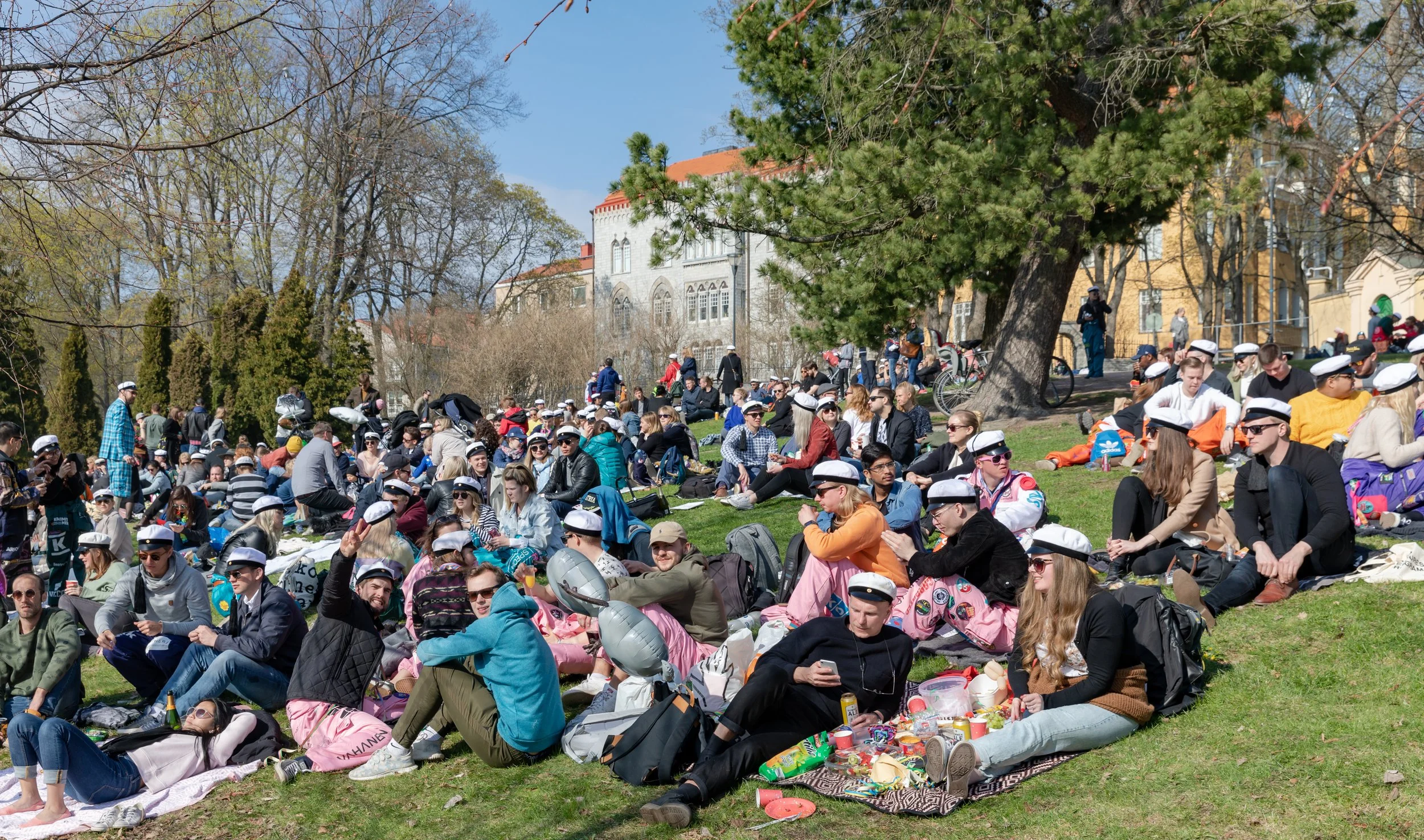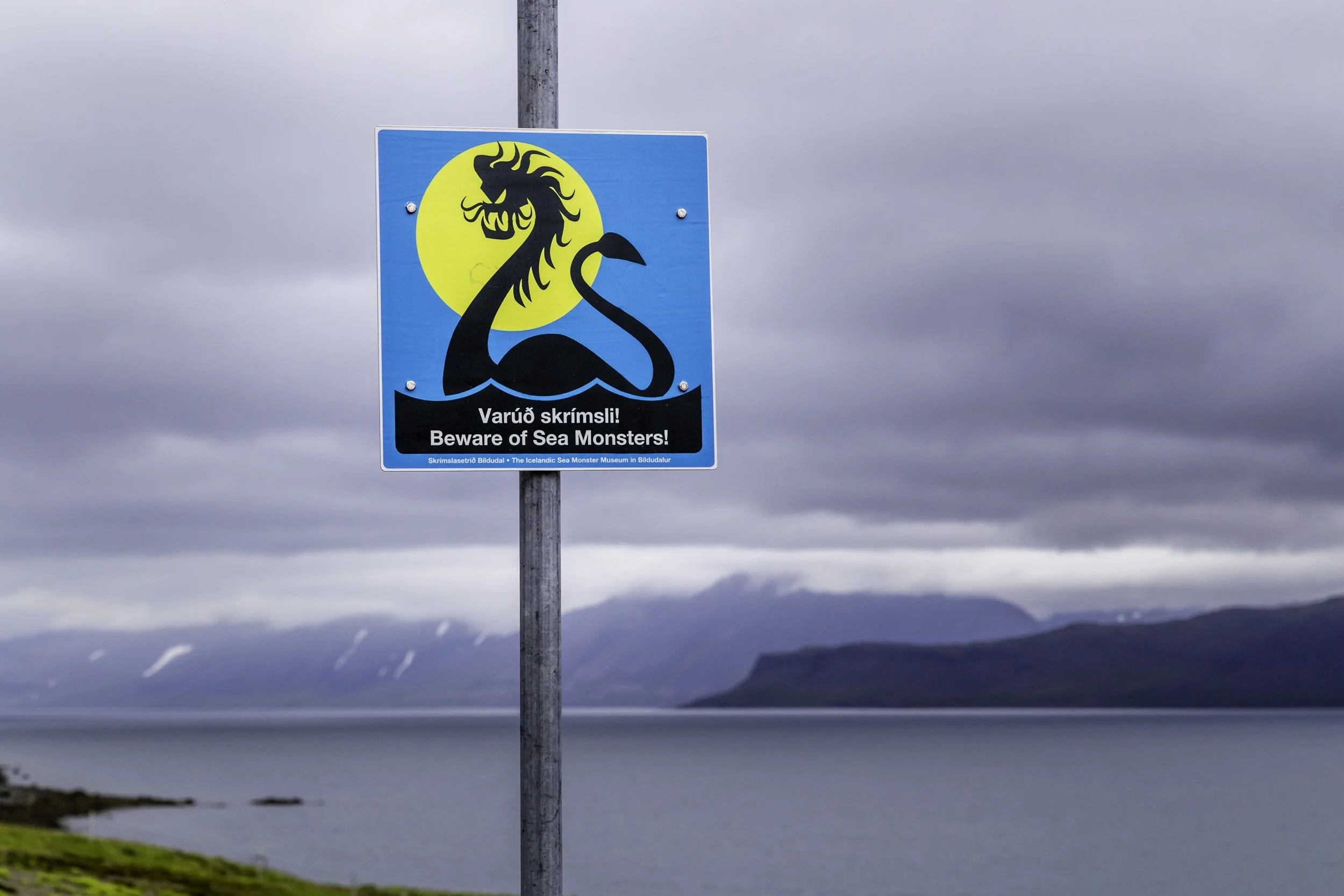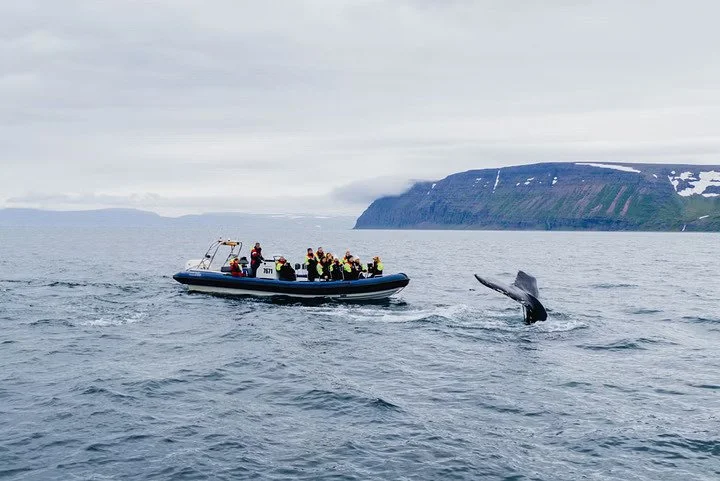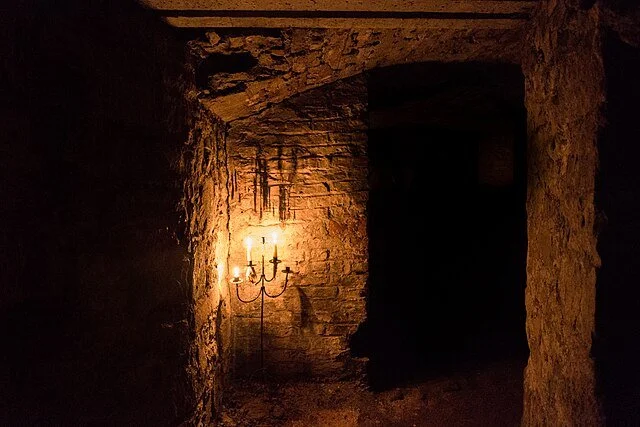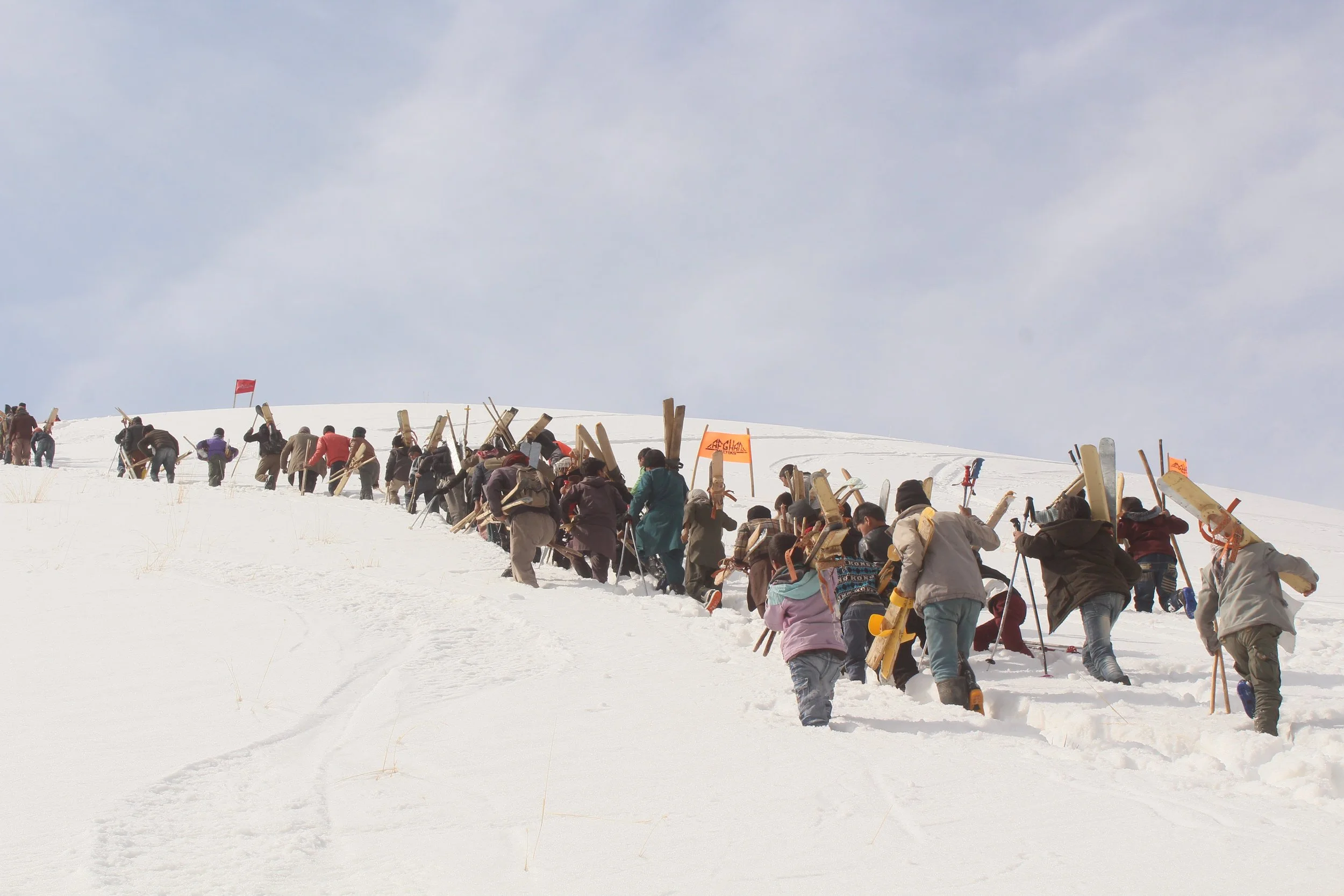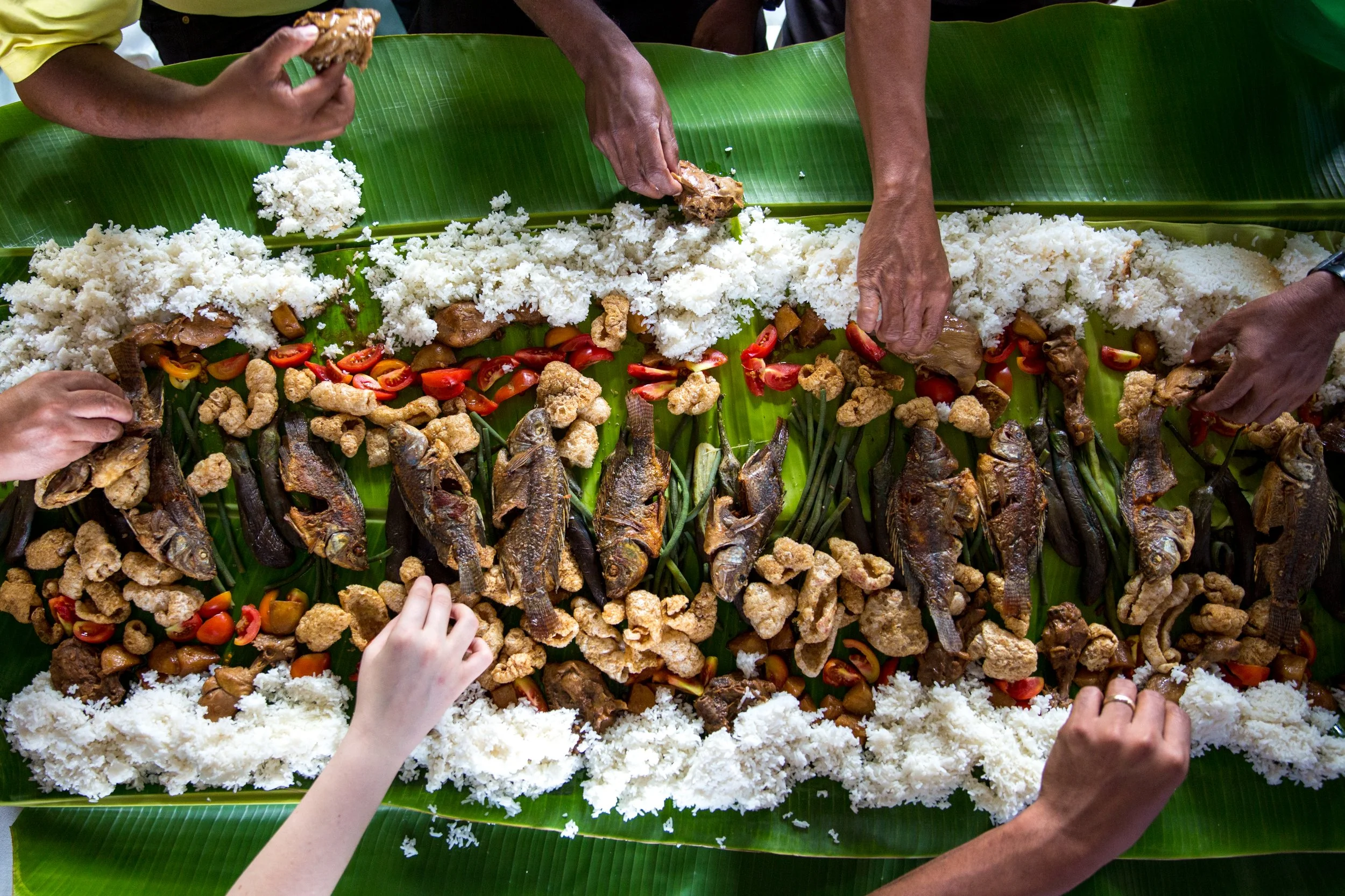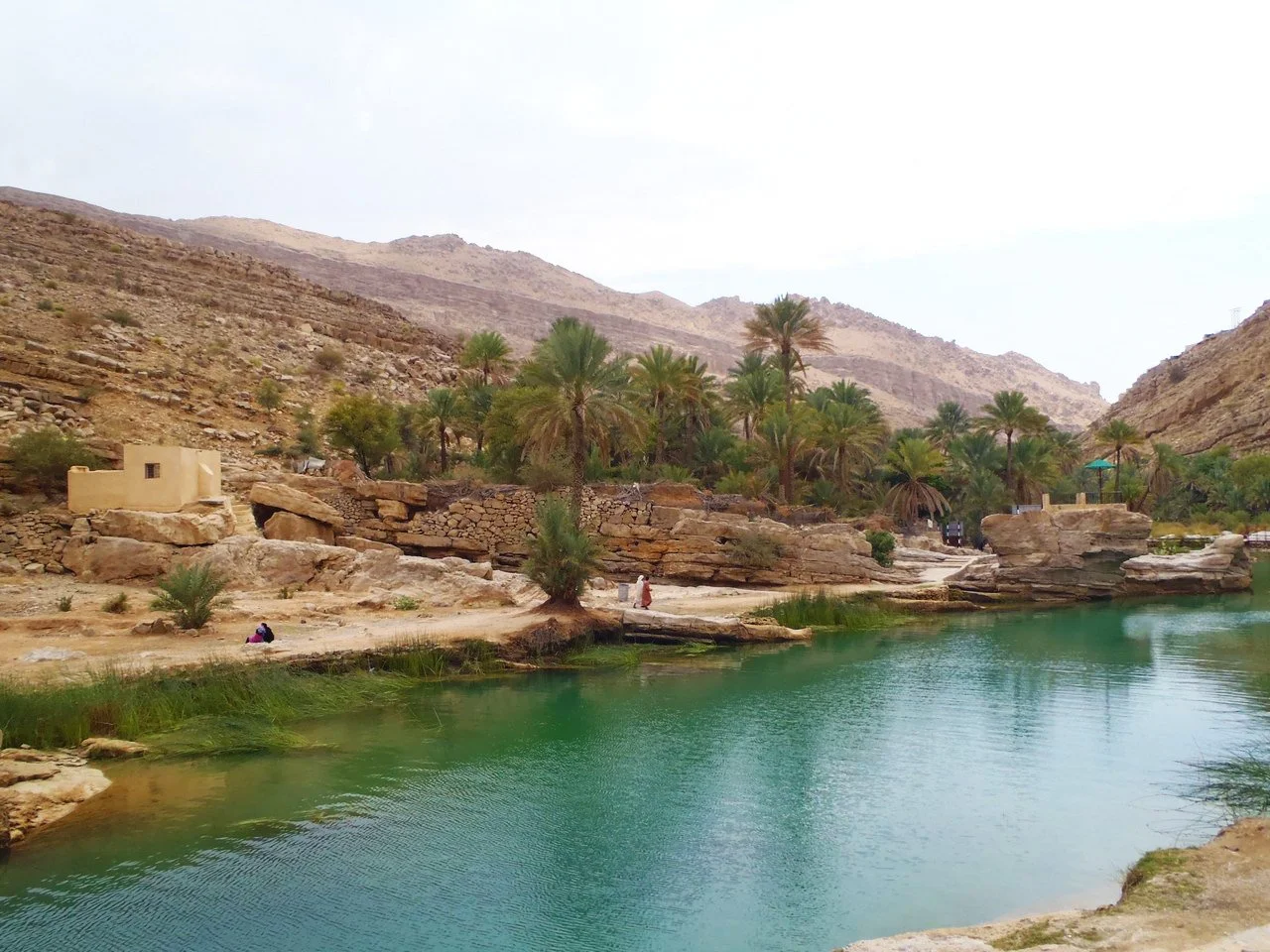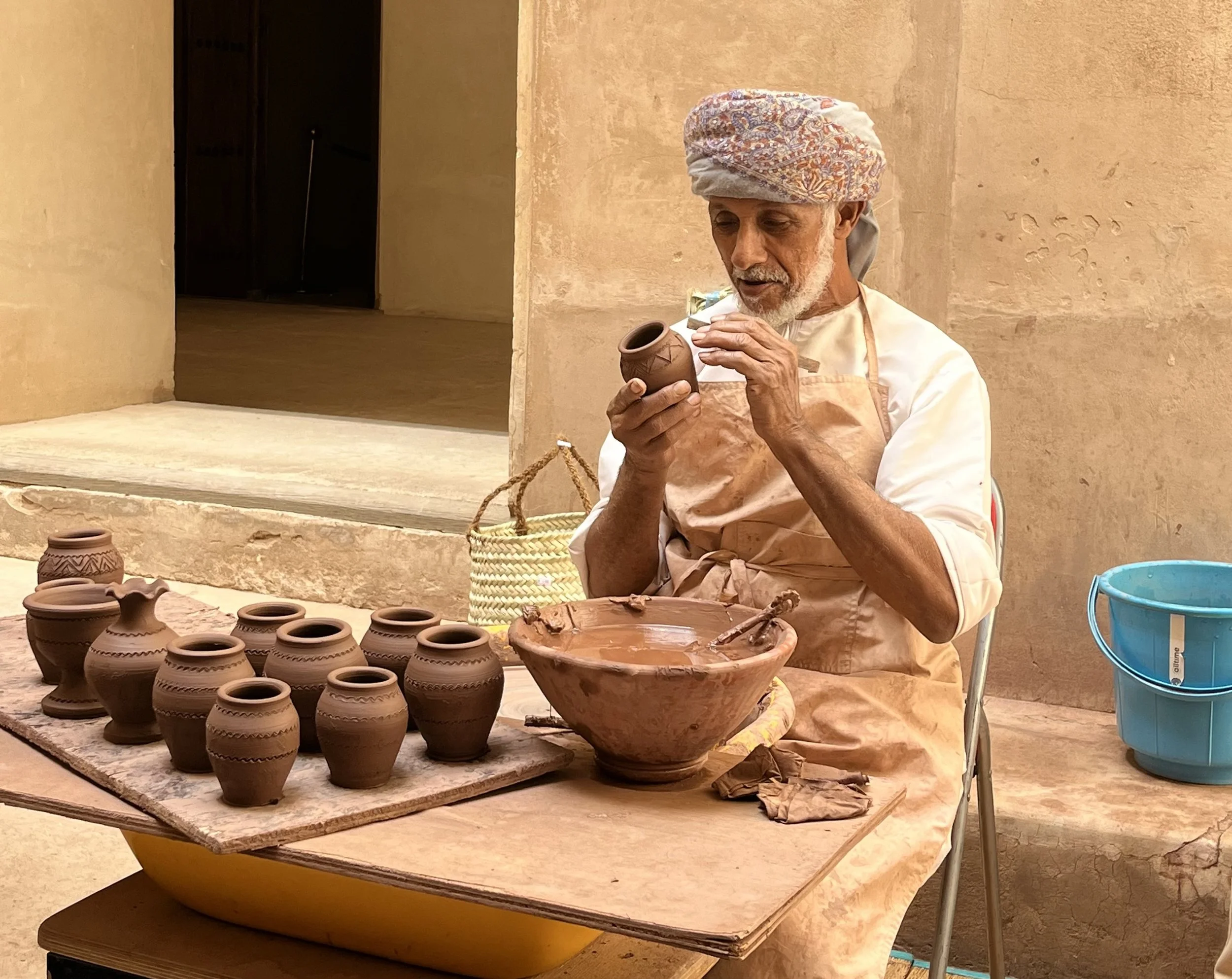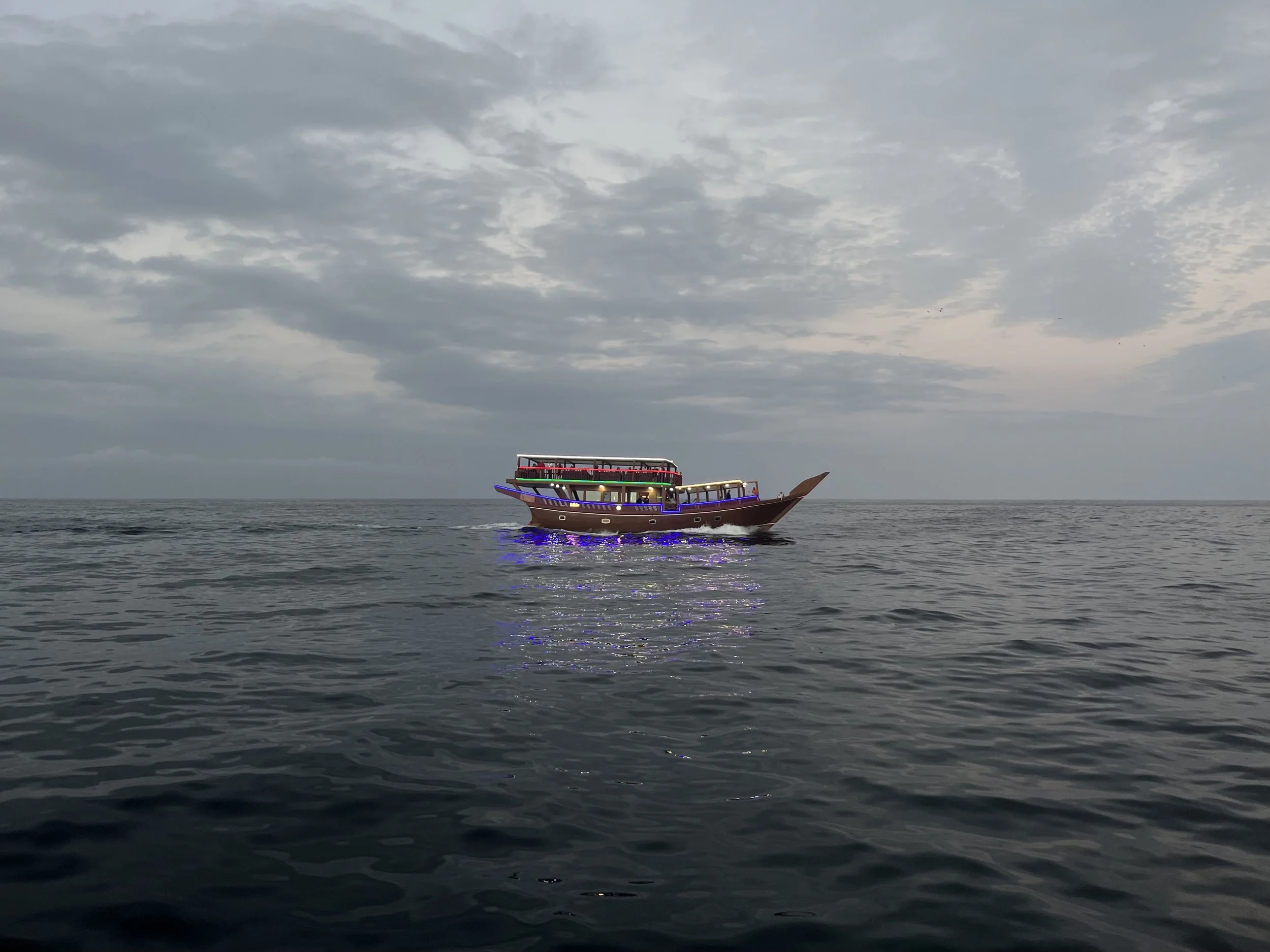Caroline Island can give us a look at what coral reefs used to be years ago.
Read MoreHow Geoffrey Chaucer Inspired Pro-Migrant Literary Social Action in the U.K.
In the U.K., writers and refugees collaborate to end indefinite detention.
Westminster in the sunlight, the destination of the Refugee Tales walk. Aswin Mahesh. CC0.
The United Kingdom’s immigration policy allows it to detain migrants indefinitely while the government resolves their immigration status. The U.K. is the only country in Western Europe with this law; other European nations have a maximum time limit to detain people, usually ranging from about a month in France to six weeks in Germany. In 2015, a group of writers and activists in the United Kingdom combined forces to create the Refugee Tales—a short story collection and an annual walk to raise awareness about indefinite detention for migrants in the U.K. The Refugee Tales seeks to put a 28-day time limit on immigration detention.
The walk mimics the style of fourteenth-century poet Geoffrey Chaucer’s “The Canterbury Tales.” In his poem, a diverse group travels from London to Canterbury, telling stories throughout the journey to entertain each other. The Refugee Tales takes a broader scope, engaging people worldwide for social change.
The Ellesmere Manuscript of The Canterbury Tales. Rob Corder. CC BY-NC 2.0
As a part of the Refugee Tales, established writers partner with those impacted by the U.K.’s indefinite detention model. The writer transcribes their narratives. Those sharing their stories may work within the immigration system as social workers or interpreters. Oftentimes, they are migrants who have experienced indefinite detention. Writers share these stories with walkers during the evening—as Chaucer’s characters did with their tales—and compile them in short story collections, read them aloud in videos, and share them in news outlets.
The written work created between author and refugee lies at the heart of the movement. Storytelling works to raise awareness about the problems migrants face on their journey to the U.K. and in these detention centers.
Scottish author Ali Smith, who wrote “How to be Both” and won the Baileys Women’s Prize for Fiction, is the patron of The Refugee Tales. She described storytelling as “an act of profound hospitality.” Transcribing the stories refugees tell elicits “sympathy and empathy” from listeners.
Smith wrote “The Detainee’s Tale,” telling of a young man who arrived in the U.K. as a victim of human trafficking. After escaping, he found a community at a church that advised him to reach out to the Home Office—the U.K.’s ministerial department responsible for security and immigration—for help.
“You do it,” Smith writes as the young man says. “You write to the Home Office. They come. They arrest you. They put you in prison for six months because the passport you’ve got is the wrong kind.”
Many British literature scholars view Chaucer as the “Father of English poetry.” “The Canterbury Tales” is a staple in many British literature classes. Telling refugees’ stories in the style of a quintessential British text is a political statement, making these refugees a part of the cultural canon and saying they deserve a place in the United Kingdom.
TO GET INVOLVED:
The Walk: The Refugee Tales will host their annual walk this year from July 6-10 from Edenbridge in Kent to Westminster in London. You can buy tickets to participate in the walk.
The Stories: For easier yet impactful involvement, listen to or purchase the books full of the U.K.’s refugees’ tales.
Annie O’Brien
Annie is a third-year student at George Washington University studying English, Creative Writing, and History. From Philadelphia, she is an avid reader, pop-culture enthusiast, and traveler. She’s always eager to talk about her adventures abroad and domestically, whether it's telling about the time she hitch-hiked in Bavaria or offering recommendations for the best bookstores in Key West. She hopes to become a published author one day. Enjoy more of her writing on her Substack.
May Day Magic: How Different Countries Celebrate
Sixty-six countries around the world recognize May Day, and a variety of different celebrations and traditions can be found throughout Europe.
May Day bouquets. Alyss. CC BY-NC-SA 2.0
The roots of May Day are in the Gaelic Beltane Festival and Roman Floralia. In 1891, the first of May also became recognized as International Workers Day. Over the years, May Day festivities have maintained ancient traditions while evolving to include modern activities from picnics to music festivals.
England
Children performing the Maypole Dance. Pete Ashton. CC BY-NC 2.0
England boasts a long history of May Day celebrations. Traditional Maypole dances can still be seen throughout the country. These dances are often performed by children adorned with flowers who hold ribbons connected to the Maypole.
The ribbons create a colorful design as the children dance around the maypole. Said to represent the increase of daylight between the winter and summer months, this tradition is around 600 years old.
Beyond witnessing this traditional dance, history enthusiasts can witness re-enactments of conflict between the Vikings and Saxons at Corfe Castle in Dorset.
Finland
May Day picnic in Helsinki, Finland. Ninara. CC BY 2.0
Finnish May Day celebrations are called Vappu, and are celebrated on April 30th and May 1st. During the festivities, travelers can see streets and parks dotted with white hats; these hats are secondary-school graduation caps, which have become a staple of the Vappu celebration.
During Vappu, Finland is incredibly lively, full of parties, picnics, parades and political speeches. These events are accompanied by several traditional delicacies, including Finnish May Day funnel cakes called Tippaleipa, Finnish donuts called Munkki, and a unique kind of mead called Sima.
France
Lily of the Valley. liz west. CC BY 2.0
In France, May Day is known to be a day of rest when nearly every business is closed in honor of Labour Day, although flower shops and stands are allowed an exception. This is because Lily of the Valley flowers, called Muguet in French, are a staple May Day tradition.
During the holidays, Lilies of the Valley are exchanged between family and friends as a symbol of good luck. During May Day, French streets are strewn with these flowers as this day marks the only time of the year when people are allowed to sell these flowers on the street without requiring a license or taxation.
Germany
Walpurgisnacht celebration, Germany. Michael Panse. CC BY-ND 2.0
On the eve of May Day, Germans celebrate Walpurgisnacht, a spring festival with a history rooted in witchcraft. This tradition has its origin in the belief that witches celebrate the coming of spring on the summit of Blocksberg Mountain. During Walpurgisnacht, festivalgoers can dance around bonfires and indulge in Maibowle, a punch made up of white and sparkling wines and wild woodruff.
On May Day, parades featuring brass bands make their way through the streets, followed by maypole dances and public gatherings filled with bratwursts and beer. A festival for dark rock and arts has also been celebrated in Leipzig since 1992, drawing goths from around the world.
Greece
Wildflowers in Greece. Kevin Casper. CC0
May Day has been celebrated in Greece long before its association with Labour Day. Protomagia, the traditional Greek May Day celebration, has been a time for Greeks to celebrate rebirth and honor the dead for centuries.
While traditions vary across regions, many feature lively singing, dancing and rituals. A few of these customs include women singing traditional May Day songs while dancing around bonfires. Children also leap over the bonfires to symbolize the end of winter and banish disease.
Greenery and flowers have long symbolized vivacity and fertility. In preparation, people collect wildflowers from the countryside and create wreaths. These wreaths can be found on balconies and doors across the country, intended to ward off evil. These wreaths are then preserved and tossed into bonfires during the Feast Day of Aghios Ioannis Klidonas on June 24th.
Ireland
May Day flowers in Northern Ireland. Etrusia UK. CC BY-NC-SA 2.0
Traditionally, Ireland celebrated the Beltane Festival, including Maypoles and May Bushes, which were usually Hawthorn bushes decorated with ribbons and occasionally colored eggshells left over from Easter.
Children in Dublin would wander the streets in search of money, candles or sweets by approaching people and saying “Long Life, a pretty wife, and a candle for the May Bush”.
While these traditions have largely died out, travelers can still find bonfires in counties like Clare and Limerick. Partygoers celebrate throughout the country, enjoying the holiday with family and friends.
Italy
May Day Concert, 2008. Gniliep. CC BY 2.0
For May Day, Italy hosts the largest free music event in Europe. The May Day Concert in Rome's Piazza San Giovanni in Laterano began in 1990 and has drawn thousands of people every year since. At this event, travelers can experience live music and street events.
Beyond the May Day Concert, Italians and visitors alike use the holiday as an opportunity to soak up the sun and indulge in Italy’s rich culture. Italy has many beaches, such as Salento, where people can celebrate the coming of spring along the water. People also flock to San Gimignano, home to incredible wine, architecture, and a UNESCO World Heritage Site at the city center.
Scotland
Performers at the Beltane Fire Festival, 2009. Martin Robertson. CC BY-NC-ND 2.0
Scotland is another destination where the Beltane Festival is celebrated. Since the 1980s, traditional Beltane celebrations have been revived with modern additions.
One of the most prominent celebrations occurs on April 30th in Edinburgh. Every year, around 10,000 people from around the world are drawn to the Beltane Fire Festival. During the festival, a procession filled with drums travels through the streets, led by traditional May Day characters like the Green Man and the May Queen.
Following the procession, there is a three-hour stage performance which is concluded by the lighting of a bonfire. At the festival, visitors have the opportunity to immerse themselves in the traditional performances and support local businesses
Madison Paulus
Madison is a student at George Washington University studying international affairs, journalism, mass communication, and Arabic. Born and raised in Seattle, Washington, Madison grew up in a creative, open-minded environment. With passions for human rights and social justice, Madison uses her writing skills to educate and advocate. In the future, Madison hopes to pursue a career in science communication or travel journalism.
Egypt’s Time Capsule: The Fayoum Oasis
A desert adventure that revealed millions of years of history and culture in just one day.
Keriann Slayton
Before the pyramids there were whales, and beyond Cairo there are waterfalls. Once a bounty of prehistoric life, the Fayoum Oasis in Wadi El-Rayan remains rich in resources, culture and history. Cascading water appears as if from nowhere, and dunes and ancient rock rise up to frame the entrance to Wadi El-Hitan, “Whale Valley,” where fossils litter the paths revealing the evolutionary development of massive marine creatures. Describing the region feels like creating an imaginary world for a fantasy novel, yet during my trip there in January 2023, I discovered it to be supremely real and of unique significance in the environmental and cultural memory of Egypt.
The heart-shaped basin spans over 500 square miles and holds stories dating back millions of years. The oasis began forming following the mass drying up of the Mediterranean Sea during the late Miocene period. When the crisis ended and the sea refilled the Nile River ultimately flooded and water flowed into the basin via the Bahr Youssef, transforming the desert expanse into a region of lush vegetation.
During my visit with my family, I immediately understood why Fayoum was home to the first Egyptians to practice agriculture and exists as one of the world’s longest continuously occupied towns. We met our guide for the day at a restaurant in the village center, which could only be characterized as storybook-esque. The open air dining area overlooked a large garden that supplied fresh herbs and produce for the kitchen, and one of the basin’s many lakes loomed in the distance. The view served as a prime introduction to the rich botanical and marine legacy of Fayoum.
Fayoum entered into a golden era during the years 1817–1860 BCE under King Senusret III. The basin began to yield high volumes of rich produce, attracting growing populations and increasing trade with other regions in Egypt and civilizations abroad. Today, the people of the Fayoum live similarly to their ancient ancestors, farming the land and maintaining its reputation as an agricultural cornucopia and cultural time capsule. I saw donkeys pulling carts carrying fruits, vegetables and people from place to place along dusty dirt roads. Wooden fishing canoes dotted the shores of expansive man-made lakes, which were connected by Egypt’s largest waterfall. The entire basin seemed to have been protected from the clattering machinery and dense fog of industrialization.
A fishing canoe in Fayoum. Masondan. CC BY-NC-SA 2.0.
After finishing up at the restaurant, my mother, father, sister and I loaded into a rugged white Jeep that transported us even further back in time. The green farmland and quaint villages soon disappeared in the rearview mirror as we sped deeper into the vast nothingness of the desert, with no visible landmarks to guide our way. Our driver seemed one with the sand, confidently navigating the dunes and never once even hinting at the possibility of getting lost. The Jeep rattled along for quite a while and, for a moment, I thought we may actually reach the edge of the Earth. Eventually, clusters of irregular shapes appeared on the horizon, and we approached the unique rock formations that marked the entrance to Wadi El-Hitan.
Keriann Slayton
Discovered by a team of geologists in 1902, the 37-million-year-old fossils of “Whale Valley” make Senusret III’s reign seem like yesterday. After hopping out of the Jeep for photos in front of a landscape that looked like it was copied and pasted from another planet, we arrived at the visitor’s center, a structure organized as a collection of concrete domes with a relatively bare interior that revealed evolutionary secrets long buried beneath the sand. As we ventured deeper into the UNESCO World Heritage site, we encountered whale skeletons stretching as long as 50 feet, and alongside skulls and spines rested the bones that made up the legs and knees of the prehistoric creatures. The fossils confirmed scientists’ long-held suspicions that whales evolved from terrestrial mammals, transitioning to full-time life in the ocean over the course of millions of years.
The most intriguing were the snake-like remains of the Basilosaurus, the enormous ancient whale whose bite marks were visible in the skulls of some smaller Dorudon skeletons. The fossils expose a history of Egypt that long predates the Pharaohs and their Pyramids, a history that predates the Nile itself. As we trekked up and down the dunes, following the fossil-flanked paths, the spirit of the ancient sea made itself undeniable even in the face of the endless desert—it began to rain.
The drizzle, so rare in the Wadi, connected me and my family across time and species to the legacy of the massive marine beings so instrumental in evolutionary history. We explored for a few hours, and when we finally emerged from Whale Valley, we piled back into the Jeep and dune-busted our way to a remote lake, arriving just in time for sunset. Our driver built a fire and made traditional Berber tea, which we drank on the shores until darkness threatened our route out of the desert and we had to depart.
I fell asleep quickly on the nearly three hour drive back to Cairo, dreaming of colorfully painted wooden boats, sledding down sand dunes, and whales with legs.
Keriann Slayton
Keriann is studying International Literary and Visual Studies and History at Tufts University, where she is a student athlete on the softball team and writes for the campus newspaper. Journalism allows her to meet fascinating people, engage with her community, and nurture her long-held passion for storytelling. She loves to fuel her interest in history and culture through travel, and she has visited Spain, Germany, Greece, Egypt, Turkey, and Italy. She hopes to share compelling narratives from around the world in order to better connect humanity across time and cultures
Palestine and Picasso: The Evolution of “Guernica” as a Symbol for Peace
As an iconic anti-war symbol, “Guernica” evolves once more amid the Israel-Palestinian conflict
Guernica on display at the Museo Nacional Centro de Arte Reina Sofía. CC BY-NC-ND 2.0.
First exhibited at the 1937 Exposition Universelle, Pablo Picasso’s “Guernica” is a mural with deeply rooted political history that extends beyond the reasoning for its inception. Commissioned by the Spanish Republican government as a work of propaganda against fascism, “Guernica” was inspired by the bombing of civilians Guernica, Spain by forces allied to Hitler. Since then, the piece has become the emblem for various anti war movements, and most recently has been adopted by those in support of Palestine.
After being exhibited at the fair in 1937, in 1939 “Guernica” made its way across various U.S. cities, and eventually was housed in the Museum of Modern Art in Manhattan for 41 years until it returned to Spain in 1981. The mural was a formidable inspiration for many American artists, such as Jackson Pollock.
Moreover, the Art Workers Coalition, a group of artists, museum staff, critics and writers, adopted “Guernica” as part of their movement against American involvement in the Vietnam War. Throughout the 60s and 70s, the group created posters featuring the mural to use alongside various slogans like, “Stop the war in Vietnam now!”
In the decades since the Vietnam War, “Guernica” has been at the root of various different protests, and was even on one occasion vandalized with the words, “kill lies all.” Most recently, the piece has been integrated into the movement for solidarity with Gaza.
This past December, a protest held at the Pasialeku Market Place in Guernica was organized by the Guernica-Palestine Citizens’ Initiative. Thousands assembled at the market and when aerially viewed, created a mosaic of the Palestinian Flag and a section of “Guernica.” The location of the protest was intentional, designed to draw similarities between the current conflict in Palestine and the civilian bombing in 1937 that served as the initial catalyst for the piece.
Though not directly related to the painting, Guernica is also a non profit literary magazine dedicated to art and global politics. The magazine features a plethora of Palestinian writers, as well as pieces on addressing the nuances of this conflict.
Recently, however, the outlet is facing backlash for releasing an article by Joanna Chen in its March issue, entitled “From the Edges of a Broken World.” The article’s publication resulted in mass resignation of the magazine’s editors. In particular, people had issues with the following: “A neighbor told me she was trying to calm her children, who were frightened by the sound of warplanes flying over the house day and night. ‘I tell them these are good booms.’ She grimaced, and I understood the subtext, that the Israeli army was bombing Gaza,” which could be interpreted as approving of the bombardment.
Some regarded the piece as “white colonialism masquerading as goodness,” in reflection of Chen’s British origins. However, in light of the controversy, many readers seeking out the essay found no problems with its content. April Zhu, a senior editor, wrote that she believed the article did not align with an “earnest, urgent, and risky resistance to U.S. imperialism and all others,” which she felt Guernica, the magazine, embodied and was founded on.
Although Guernica’s editor-in-chief, Jina Moore, resigned on April 5 amid the backlash, she maintains that the article aligns with what the publication is known for. In her statement of resignation, she said, “I saw the piece as an example of the difficult work that Guernica is known for: capturing, with complexity and nuance, how such violence is normalized, and how a violent state extracts complicity from its citizens.” Ultimately, her decision to resign reflects her support for the article, despite the magazine maintaining its decision to retract the piece. Aligned with the history of the painting, Guernica as a magazine shows that voices can diverge, even with the goal of peace at their roots.
Nicola DeGregorio
Nicola is studying English Literature at George Washington University, where she also reports for the student newspaper, The Hatchet. Nicola's passion for literature and writing has sparked an interest in exploring the broader context surrounding written texts. Researching and writing for Catalyst Planet allows her to investigate nuanced issues that intersect with her interests in art history, culinary practices, and cultural traditions.
World Nomads’ Footprints in Responsible Tourism
Travelers are able to contribute directly to communities and wildlife conservation projects through the travel insurance company World Nomads’ Footprints initiative, raising both awareness and money.
Read MoreNoon Against Putin: Russian Citizens Continue Navalny’s Mission
In Russia, protests in opposition to Putin’s rule continue despite the death of Alexei Navalny.
The late Alexei Navalny. Mitya Aleshkovskiy. CC BY-SA 4.0
On February 16, 2024, Alexei Navalny, outspoken critic of Vladimir Putin and major activist in Russian domestic politics, died in a Russian prison. On March 17, 2024, believers in Navalny’s vision took the next step in opposition to the president.
Despite his death, Navalny’s anti-Putin rhetoric continues to echo through the streets of Moscow. On the final day of the 2024 Russian presidential election, groups of silent protestors gathered at polling places across the country at exactly twelve o'clock noon in a demonstration dubbed “Noon Against Putin.” The plan had been endorsed by Navalny prior to his death, and the call was taken up afterwards by his widow, Yulia Navalnaya, via a video on YouTube in the days before the election.
The demonstrators voiced their disapproval of the unfair elections by either writing in Navalny’s name on their ballots, invalidating their vote, or simply leaving without voting at all. Around the world, Russian citizens also formed silent queues at embassies in Berlin and London, standing in solidarity with the demonstrators in Siberia and Moscow. Many also took to social media to decry what they called an unfair and rigged election, denying the Kremlin’s repeated claims that their president is always democratically chosen.
Protestors outside of a polling place in Moscow. Konopeg, CC0
Navalny was one of the few Russian citizens willing to outright oppose Vladimir Putin’s rule. He was arrested several times for leading protests against corruption in the Kremlin and eventually joined a centrist political party to work towards fair and just elections, among other humanitarian improvements in the daily lives of the Russian people. Navalny’s death in a Russian prison in the Arctic sparked outcry worldwide, with many world leaders accusing Putin of direct involvement.
A procession outside the Russian Embassy in Berlin. A.Savin, Free Art License
“Noon Against Putin” was carried out with the knowledge that some arrests were inevitable. The demonstration ended with at least 60 citizens imprisoned and 15 criminal charges filed. Not only did the people gathering at the ballot boxes understand that their demonstration would not change the election, but they also came in spite of the laundry list of potential punishments from the authorities. The threats of imprisonment, and possibly death in captivity, hang over the heads of any Russian citizen who speaks out against the Kremlin. But the community that Navalny has built seems unafraid of these consequences. Even though Putin was still reelected, this brief and solemn display of unity among the Russian people shows that even without their vocal leader, the anti-Putin masses are still here, and are still willing to show their disapproval.
The Kremlin, and thus Vladimir Putin, still holds complete control over Russia and its government, but the forward momentum that these protestors represent, no matter how small it may appear now, suggests a potential shift in the balance of power. In the past, Russian citizens have had little choice but to put their heads down and keep moving forward. Today, Navalny’s memory has spurred those same citizens to take action towards a vision of change.
Ryan Livingston
Ryan is a senior at The College of New Jersey, majoring in English and minoring in marketing. Since a young age, Ryan has been passionate about human rights and environmental action and uses his writing to educate wherever he can. He hopes to pursue a career in professional writing and spread his message even further.
Exploring Iceland’s Westfjords
Delve into the natural beauty and memorable experiences awaiting in Iceland's overlooked northwestern region.
A small town on a fjord in the Westfjords, Iceland. RaulHudson1986. CC0.
The serene and volcanic landscapes of Iceland have attracted adventurous travelers for many years, especially the popular Golden Circle and Ring Road routes. Yet, both paths exclude one of the most scenic areas of the country, the Westfjords.
The Westfjords of Iceland is a sparsely populated, panoramic region with little geothermal activity that many travelers often overlook. Despite this neglect, there are many amazing experiences here to add to your Icelandic adventure.
1. Dynjandi Fjallfoss Trail (Arnarfjordur)
Dynjandi Fjallfoss in Arnarfjörður, Iceland. Jacqueline Macou. CC0.
This majestic waterfall is the largest in the region and is frequently referred to as the Westfjords’ most beautiful attraction. It is part of a series of seven waterfalls that unravel down the peak, originating from the waters of Lake Stora-Eyjavatn. The sound that emanates from these falls mimics thunder, and it’s understood why the waterfall’s name, Dynjandi, translates to “thunderous” or “booming."
From the parking lot, you can hike your way up the seven waterfalls, but take caution as it can be quite slippery and mossy. The average person can do this hike in around 15 minutes, but it is recommended to take your time to enjoy each one. At the peak, you can revel in the mist of the magnificent waterfall, try the fresh glacial water, and look out over the extensive views of the fjord upon your descent.
2. Museum of Everyday Life–Hversdagssafn (Isafjordur)
Museum guests in the sensory lab in Ísafjörður, Iceland. Courtesy of Hversdagssafn.
This museum provides an intimate perspective on the everyday life of Icelanders that is largely overlooked in mainstream tourism of the island. Founders Vaida and Björg refer to Hversdagssafn as more of an art project under the guise of a museum, one that aims to collect human connection. From exhibits on family histories told through donated books from the old church, short films about the winter seasons and a local distaste of the Northern Lights to heartfelt reflections on being an immigrant in Iceland, this museum is sure to give you a fresh perspective on life in the Westfjords and the pillar of community using all five of your senses.
3. Hike to Hornstrandir (Hornstrandir)
Hiker crossing the river in Hornstrandir on a trek to Hornbjarg cliff. Kristyna Sindelkova. CC0.
Hornstrandir (227-sq-mi) is an uninhabited area of the Westfjords that is only accessible by boat during the summer between June and August. It’s frequently called “Europe’s last wilderness” and deemed a “hiker’s paradise.” All of the homes on the peninsula have been restored since the last farmers left in 1952.
After establishing Hornstrandir as a protected Nature Reserve in 1975, the area’s 250 species of flowering plants and 30 species of nesting birds have thrived. Up to six million birds nest on the cliffs during the summer, with species including the Atlantic puffin, Arctic terns, black guillemots and penguins. It is the only sanctuary for Iceland’s prized native mammal, the Arctic fox. As the region is uninhabited and the animals are protected, the foxes have no fear of travelers and will often raise their kits near campsites. Polar bears have also been known to drift on ice to Hornstrandir from Greenland, though this occurrence is rare.
The area’s tundras, cliffs, flower fields and ice prove to be exciting hiking routes for self-sufficient adventurers. You can enjoy the vast region through multi-day hikes or day trips where you can eat traditional cuisine at the Old Doctor’s House. You can also do multi-day kayak tours that weave in and out of the fjords and camp overnight in the wilderness or at sleeping bag accommodations. Guided tours are highly recommended, and booking in advance is required.
4. Tjöruhúsið (Ísafjörður)
Town of Isafjordur in the Westfjords of Iceland. Gestur Gislason. CC0.
Immerse yourself in this Icelandic fish buffet, only open for dine-in during the summer season, for a communal dining experience with unlimited access to a range of unique platters and local music. It is a family-owned and run restaurant that has no menu, as the restaurant caters to the catch of the day. The atmosphere is warm, welcoming and familial. Plates vary from traditional Icelandic fish stew, to thorskkinnar (cod cheeks), monkfish and more. The restaurant also serves as a meeting space for public events within the community. Reservations for the lunch and dinner serving times during the summer seasons are highly recommended to ensure a seat at the delicious buffet-style gathering.
5. The Icelandic Museum of Sea Monsters (Bíldudalur)
A cautionary sign was posted along the road in Iceland. Dendron. CC0.
Take a step back in time and discover old Icelandic lore and legend of the creatures that may or may not have plagued the Nordic seas. This region is known across Iceland for its historic reputation for prolific sea monster activity. At the Icelandic Museum of Sea Monsters, visitors can witness the extraordinary creatures of the deep vividly portrayed through an immersive and interactive blend of language, visuals and videos. Eyewitness testimonies are paired with scholarly insights into the realm of sea monsters, as on-screen narratives and academic perspectives infuse the space. Moreover, an array of relics and artifacts, serving as tangible remnants, color the museum, offering compelling evidence of their existence. The museum also has impressive interactive maps that draw on all kinds of monster legends from around the world.
Additionally, as you visit the museum, a highly recommended pitstop nearby is Reykjafjardarlaug Hot Spring, a geothermal pool just outside of the town for an ideal rest in warmed geothermal waters.
6. Whale Watching
Whale watchers aboard a RIB boat in Iceland. Courtesy of West Tours. CC0.
The waters of the Westfjords are home to many arctic species, including up to 20 species of whale. Here you will likely encounter dolphins, humpback whales, beak whales, minke whales and orcas. These polar water tours are frigid and icy and thus can be experienced on more relaxed boat tours. However, if you are looking for a more adventurous and open-air whale-watching tour, you can opt for an open RIB boat safari where you can feel the pulse and spray of the ocean while capturing up-close views of marine life. Most tours depart out of Isafjordur or Holmavik and last two to six hours. Almost all tours guarantee incredible whale and nesting bird sightings.
Whale watchers experiencing a whale sighting in Iceland. Courtesy of West Tours. CC0.
Julz Vargas
Julz is a student at Wellesley College studying Anthropology and Spanish. She grew up in Los Angeles, CA, and has studied all around the world in places such as Costa Rica, Greece, Iceland, and Spain. She is passionate about employing writing as a tool to explore human connection and diversity. Julz aspires to foster cross-cultural connections through community-based research, amplifying inclusive and diverse media about global cultures, foods, and people, to encourage individuals to engage more wholly with the world.
Exploring Mauritius: 6 Must See Destinations
This tiny island nation in Africa offers destinations exploring its complex colonial history, stunning beaches and unique outdoor adventures
Read MoreIntroducing a Travel Brand Dedicated to Positive Social Change: CATALYST PLANET
Are you looking for your next adventure? What about one that you can take from the comfort of your own home? With CATALYST PLANET, you need only your laptop to immerse yourself in cultures and destinations from every corner of the globe. And, if you want to travel, CATALYST PLANET can help with that, too. To get CATALYST PLANET directly to your inbox sign up here.
CATALYST PLANET is a global community of activists, conscious travelers and creators, who share a passion for adventure and activism. As a publication that sheds light on urgent global issues through engaging content and transformative travel experiences, CATALYST PLANET is the future of social impact travel.
If you’re itching to embark on your next journey, CATALYST PLANET’s Travel section is the perfect starting point. As a gateway to exploration, every click leads you to new destinations and articles that are organized by continent. Whether you’re looking to enjoy a literary pilgrimage in Colombia, experience Antarctica’s natural beauty, or even meet penguins in South Africa, the travel section has it all. At CATALYST PLANET, you’re invited to satisfy your wanderlust, where every article is a ticket to a different destination.
With captivating social impact articles that explore topics ranging from climate change to human rights, videos that bring distant cultures to life, and podcasts to challenge your perspective, global citizens will find there is always something, or someplace, new to discover. Dive into the stories of women tuk-tuk drivers as they fight discrimination in Cambodia, famine in Sudan due to climate change and political unrest, and how to authentically experience culture while supporting locals.
And that’s only the beginning. CATALYST PLANET offers travel tools and tips to ensure traveler satisfaction while keeping the planet and local communities in mind. Here, you’ll find an abundance of practical trip tips and tools designed to enhance your travel experience. Need to score discounted airfare for your international flights? Looking for a digital nomad visa that’s easily accessible? Or do you just want to know what to pack in your bag? Regardless of what you’re looking for, CATALYST PLANET offers invaluable insights into travel tricks to make your journey smooth and empower you every step of the way.
For folks ready to make the switch from armchair traveler to globe-trotter, you’re in luck too. Not only does CATALYST PLANET offer insightful media and immersive content, we know that travelers are frustrated, spending hours searching for trips that align with their future-forward, local-first, eco-friendly and sustainable values. They want to travel and do it right. What sets CATALYST PLANET apart from other travel brands is our community’s commitment to raising the bar on ethics and sustainability. We’ve done the leg work, so you don't have to. By using the Take A Trip tool, individuals can discover over 100+ small group tours that are meticulously curated for travelers devoted to conscious exploration. Trips can be filtered by location, interest, cost, duration and more, so that travelers can easily find journeys that better suit their own budget and values.
Whether you crave eco-travel, volunteer trips, cultural immersion, or a wild adventure, CATALYST PLANET has you covered. Volunteer to help animal shelters in South Africa, explore the beaches and temples of Bali, or ski down the slopes of the Koh e Baba in Afghanistan. Our list of vetted organizations and adventures grows weekly. With CATALYST PLANET, you’ll receive your passport to the next generation of conscious travel and activism.
Are you ready to take the leap to join the next generation of activists and conscious travelers? To learn more about CATALYST PLANET, sign up for our newsletter or give us a follow on social media to stay updated on what could be your next adventure. Start your exploration today to join us in creating a brighter tomorrow through future-forward travel and social action—let's see the planet and change the world together.
Follow us on social media
A Festival of Flight: Explore Japan’s Hamamatsu Kite Festival
Join more than 1.5 million people in May to celebrate the Hamamatsu Kite Festival.
Kites flying during the Hamamatsu Kite Festival. Shizuoka Prefectural Tourism Association. CC BY-SA 2.1 JP
The origins of the Hamamatsu Kite Festival date back more than 450 years. In Japan, kites have been used for both practical and celebratory purposes for over 1,000 years. During the Edo era, kites were flown to celebrate the birth of a first-born son. This tradition then developed into the Hamamatsu Kite Festival where all children are celebrated.
At the beginning of May during Golden Week, Hamamatsu’s skies are filled with over 100 vibrant, traditional kites. The designs of the kites in the Hamamatsu Kite Festival symbolize children and traditions from each town in the district of Hamamatsu. The kite fliers then partake in an aerial battle, attempting to sever each other's kite strings.
As dusk falls, the festivities move from the beach to the city center where the streets come alive with dance and musical performances featuring bells and drums. The traditional music follows nearly 100 artfully decorated floats as they travel through the streets of Hamamatsu. The floats carry children in customary clothing and are pulled by cheering adults with lanterns and flags in hand.
Some floats are over 100 years old, and travelers can learn about their history at the plaza between the JR-Hamamatsu and Shin-Hamamatsu train stations where a few floats are displayed throughout the day. There are three parade routes, so for those hoping to see all the floats it is recommended that they choose a different route each night.
The location of the kite battles on the Pacific coastline allows travelers easy access to other nearby marvels, such as one of three of Japan’s major sand dunes. The Nakatajima Dunes, known as a famous hatching ground for loggerhead sea turtles, can be found near the kite battles, and are surrounded by coastal forests.
Not only home to its eponymous Kite Festival, the city of Hamamatsu is a destination known for its diverse landscapes and impeccable craftsmanship. Along with the coastline, Hamamatsu boasts mountains, a river and Lake Hamana, the birthplace of Japan’s eel-farming industry. Energetic travelers can participate in many activities at Lake Hamana, including windsurfing, swimming and biking.
Nature lovers will feel right at home among thousands of plant species at the Hamamatsu Flower Park. History buffs can learn about the city’s musical history at the Hamamatsu Museum and explore Hamamatsu Castle.
Hamamatsu is easily accessible from Tokyo. Travelers can take a bullet train from Tokyo Station to Hamamatsu Station in as little as 100 minutes.
Madison Paulus
Madison is a student at George Washington University studying international affairs, journalism, mass communication, and Arabic. Born and raised in Seattle, Washington, Madison grew up in a creative, open-minded environment. With passions for human rights and social justice, Madison uses her writing skills to educate and advocate. In the future, Madison hopes to pursue a career in science communication or travel journalism.
Buried Tragedy: The Slums Beneath the Streets of Edinburgh
A long-buried mini-city beneath the streets of Edinburgh sheds light on the lives of its 19th century poor
The Edinburgh Vaults. fw42, CC BY 2.0
The city of Edinburgh is known for its gorgeous architecture, rich history and fascinating culture, and over many years has become a prime destination for tourists visiting Scotland. But beneath the Royal Mile lie hidden catacombs and an unsettling history of poverty and crime.
Despite being used as a prime spot for chintzy “ghost tours”, the underground city (referred to varyingly as the Edinburgh Vaults and South Bridge Vaults) has a rich and tragic history. It was constructed back in 1788 as part of the South Bridge Act, which was an attempt to make the rapidly-growing city more traversable. The bridge wasn’t only for travel, however; the arches under the bridge were home to tenement buildings designed to turn the area into a marketplace. The nearly 120 individual vaults became taverns, workshops and storage units for merchants.
Storage in the Edinburgh Vaults. Kjetil Bjornsrud, CC BY-SA 2.5
However, these vaults were not properly sealed against water and eventually started to flood, leading to most businesses completely abandoning them before the turn of the century. The rooms were left largely empty as the Industrial Revolution swept across Britain, and eventually became slum housing for the city’s poor. As jobs began to be automated, more and more citizens were without income and found themselves unable to pay for their homes, sending them out onto the streets and, eventually, down to the South Bridge Vaults.
Since the vaults were almost totally blocked off, many of them were without air circulation and sunlight. This, coupled with a lack of running water and sanitation, made living down in the vaults a waking nightmare. Over time, the vaults became more and more crowded, with many housing several families at once.
A recreation of living conditions in the Vaults. Shadowgate, CC BY 2.0
The vaults were also entirely avoided by the city police. As a result, they became a hotspot for all kinds of crime, from theft and prostitution to murder and body snatching. Rumors have circulated for years that a pair of notorious serial killers used the vaults to store corpses that they would later sell to medical schools for use in classes. While the killings did occur, there is no evidence that the criminals actually used the vaults to store their victims.
It is unknown exactly when the vaults were finally shut down. At some point, they were cleared out and sealed off with rubble to prevent new inhabitants. The vaults were left completely forgotten underneath the city until being discovered and excavated in the 1980s. In the years since, various clubs and venues have taken up residence in the vaults, but the vast majority are still used for ghost tours.
The history of these vaults is overshadowed by the pop-culture appeal of their supposed hauntings, but their very existence shines a light on the grim conditions faced by the poor in the 19th century. The appalling conditions in which these impoverished people lived is bad enough, but the indifference shown by the city’s government was far worse, letting criminals run rampant and leaving entire families essentially trapped in the sunless, disease-ridden catacombs. Today, the vaults serve as a reminder of the shortcomings of industrialism and the suffering endured by the poor around the world throughout history.
Though much of the vault network is still closed off to the public, there are many different tour companies in the city that guide visitors through the accessible rooms. Despite being billed most often as “ghost tours,” the guides are more than receptive to questions about the vaults’ history and tend to spend just as much time describing the vaults themselves as the ghosts that ostensibly still haunt them. Mercat Tours, a well-regarded historical tour company in Edinburgh, does adults-only evening tours regularly, with ticket prices around $28.
Ryan Livingston
Ryan is a senior at The College of New Jersey, majoring in English and minoring in marketing. Since a young age, Ryan has been passionate about human rights and environmental action and uses his writing to educate wherever he can. He hopes to pursue a career in professional writing and spread his message even further.
Ski Trips Make a Comeback in Afghanistan
Untamed Borders navigates powder and a new administration as adventure enthusiasts transcend cultural and geographical borders
Tourist Skiing in Afghanistan. Neil Silverton
Afghanistan’s ski slopes have witnessed the return of tourists for the first time since the new Taliban government came into power in 2021. Untamed Borders is a UK based travel company, formed in 2008, that focuses on providing travel opportunities to some of the world's most interesting and inaccessible places. In 2011 it pioneered excursions to Afghanistan, and has recently decided to resume its trips to the non-traditional ski tourism destination.
The group sponsored onetrip in the winter of 2024 that lasted from February 22nd to March third. It began in Islamabad, Pakistan and ended in Kabul, Afghanistan. It was a magnet for those looking to experience the region’s rugged yet beautiful landscape. Skiers started in Pakistan, where they received visas, before flying to Kabul and driving to Bamian to spend four days skiing.
Group Skiing in Afghanistan. Ana Tasič, Untamed Borders
In 2025, the company is set to continue its trips to Afghanistan. For this upcoming year the trip will be set in the Bamian Province once again, with skiing taking place in the Koh e Baba Mountain range. Similar to past trips, travelers are expected to end in Kabul and begin by venturing through Islamabad and Peshiwar, Pakistan. Skiers will have the opportunity to be led by local guides, who will help them explore Afghanistan’s popular slopes and to experience backcountry skiing on routes that may have never been skied before. Travelers will additionally have the opportunity to visit the remains of Bamian’s famous Buddha statues, the ancient city of Shahr e Zohak and take part in the Afghan Peak Ski Race.
Ana Tasič, an international guide for Untamed Borders, emphasized the beauty of the trip to Bamian Province, highlighting the drive through the outskirts of the snowy Hindu Kush Mountains. She explained that it typically takes around four to six hours to get to the Province but that “the journey through the mountains is spectacular.”
Afghan Peaks Ski Race. Afghan Peaks Charitable Trust.
Each year, the annual ski trip run by Untamed Borders coincides with Afghanistan’s annual Afghan Peak Ski Race. International groups will be offered the opportunity to take part in it alongside locals. The race typically includes two different types of skiing. One race is for people using wooden skis and the other is for those using conventional skis. The competition allows people of all ages to compete, but has faced some challenges that allow women to participate as a result of the Taliban taking over. Tasič, a former teacher of the ski club for girls, mentioned the changes in government over the past couple of years that have prevented the participation of women.
“We can’t do anything with women in sports anymore, so this has definitely changed but there’s not much that we can do about it. We’re hoping that this changes in the next few years,” she said.
The new regime in Afghanistan has not created the need for Untamed Borders to up security considerations. Because the Taliban now run Afghanistan there is less of a worry over unpredictable attacks than before, although getting into the country has become complicated. While some changes have been made in regards to travel planning, Tasič reassured those considering the trip that although “a lot has changed in the last eight years, one thing that stands out is the hospitality of the people there.” She mentioned how the trip is an opportunity for travelers to not just meet locals but to spend a week with them and get to see how they live.
“We get to experience Afghanistan in a way that most people don’t. It’s not just a ski trip, but it’s also a cultural and hospitality trip,” Tasič said.
TO GET INVOLVED
For the 2025 trip, those interested can find more information on Untamed Borders’ website. The trip to Afghanistan costs $2,850 USD and dates are not yet finalized, but when they are they will be posted to the same site for travelers to easily access.
Mira White
Mira is a student at Brown University studying international and public affairs. Passionate about travel and language learning, she is eager to visit each continent to better understand the world and the people across it. In her free time she perfects her French, hoping to someday live in France working as a freelance journalist or in international affairs.
Beyond the Quakes: Taiwan’s Earthquake Preparedness
Despite being hit with a 7.4 magnitude earthquake during rush hour on April 3rd, 2024, Taiwan has emerged largely unscathed. Why is that?
A seismogram of the April 3rd, 2024 earthquake in Taiwan. James St. John. CC BY 2.0
On April 3rd, 2024, the strongest earthquake in about 25 years rocked the streets in and around Hualien on the east coast of Taiwan, followed by hundreds of aftershocks. While the search for survivors remains underway, so far 13 people have been found dead, and nearly 1,000 people have reported injuries. While any number of deaths and injuries is tragic, these figures are minuscule compared to the near 2,500 dead and 100,000 injured during the 7.7 magnitude earthquake that struck in 1999 and left approximately 50,000 homes destroyed.
Considering its location along the Ring of Fire and the presence of three seismic belts in the country, Taiwan has a long history of earth-shaking events. The Ring of Fire refers to a fault line around the Pacific Ocean that is home to a majority of the world’s earthquakes. Because of this, Taiwan records an average of about 2,200 earthquakes every year, with a record of nearly 50,000 during 1999. Taiwan’s mountains then amplify the impact of earthquakes, which resulted in the landslides that accounted for most of the deaths on April 3rd.
Because of this susceptibility and catastrophic earthquakes in the past, Taiwan has developed some of the best earthquake preparedness techniques in the world. Following the devastating Chi-Chi earthquake in 1999, the Taiwanese government began reforming construction regulations. This included seismic retrofitting in buildings and infrastructure across the country and the prosecution of inadequate construction practices. Years of experience have also resulted in efficient emergency response, aided by surveillance cameras and social media used to identify locations requiring aid.
Educating the public has been another initiative to prevent deaths during earthquakes and aftershocks. In addition to public awareness campaigns, the Central Weather Administration frequently publishes resources including information and tips surrounding earthquake preparedness. The Central Weather Administration has also run a real-time seismic network since 1994, which tracks data and notifies the public of seismic activity through an early warning system. The data collected by the seismic network is also used to update building codes.
GET INVOLVED
Ways for people to support Taiwan’s emergency response and earthquake preparedness include donating to and supporting organizations such as the Red Cross, Taiwan Root Medical Peace Corps and Peace Winds America.
Madison Paulus
Madison is a student at George Washington University studying international affairs, journalism, mass communication, and Arabic. Born and raised in Seattle, Washington, Madison grew up in a creative, open-minded environment. With passions for human rights and social justice, Madison uses her writing skills to educate and advocate. In the future, Madison hopes to pursue a career in science communication or travel journalism.
How to Authentically Experience Culture While Supporting Locals
Getting in touch with locals is the perfect way to engage meaningfully with all a destination has to offer.
A meal shared in the Philippines. Avel Chuklanov. CC0 1.0
Whether you are growing distrustful of hyped social media recommendations when traveling somewhere new or are merely trying to find a way to support locals on your journey, there are many ways to create an enjoyable trip while experiencing the beauty of a city from the perspective of one of its inhabitants. From sharing meals to discovering the delights of a city beyond mere tourist attractions, engaging with locals is an excellent way to enjoy the unadulterated beauty of a destination.
For many, part of immersing themselves in a culture revolves around the dinner table. Although both dives and upscale restaurants offer a plethora of meal-sharing experiences, there is nothing like enjoying a home-cooked meal. Spanning 6 continents, Traveling Spoon connects travelers with locals hoping to welcome tourists to their culture through the power of food. Whether it be a traditional cooking class using family recipes in Ecuador or gaining new insight into French cuisine through a vinegar tour in Cognac, the website provides a variety of options for travelers to experience a full range of culinary experiences. From market tours to cooking classes, Traveling Spoon cultivates connections and allows those coming from near or far to feel at home when abroad.
Similar to Traveling Spoon, Eat With is a popular sight for travelers looking to get an authentic food experience. While Traveling Spoon offers more destinations, eatwith.com is a good source for those visiting major cities such as New York, Rome and Paris. Both sites offer experiences as low as $15, but some vendors can charge into the hundreds of dollars depending on the city and precise details of the experience.
With 151 destinations spanning 40 countries, theInternational Greeter Association is a non-profit offering free walking tours around various cities. Started in 1992 in New York City, this free-of-charge service is now expanding again after the Covid-19 pandemic. The greeter network is composed of passionate locals looking to show off what their city has to offer and to provide a friendly face to those visiting.
The not-for-profit nature of the organization makes utilizing the International Greeter Association an excellent way for tourists to engage with a city and its culture from an insider's perspective; learning about local gems, using public transport and discussing the greeter’s personal relationship with their city can be a great way to engage on with a destination on a whole new level, and maybe make a friend along the way.
Although social media is riddled with hyped restaurants and attractions that can make searching for cultural authenticity difficult, following creators that unveil local secrets is an excellent way to leverage new technology. For example, Elizabeth and Sophie Michilli are a mother-daughter duo from Italy who showcase their experiences in Puglia and Rome, highlighting local favorite restaurants and boutiques. Though it can be difficult to navigate through sponsored and algorithmically recommended content, using social media as a tool to engage with local creators can be an effective way to meaningfully tailor your trip to support local establishments.
Nicola DeGregorio
Nicola is studying English Literature at George Washington University, where she also reports for the student newspaper, The Hatchet. Nicola's passion for literature and writing has sparked an interest in exploring the broader context surrounding written texts. Researching and writing for Catalyst Planet allows her to investigate nuanced issues that intersect with her interests in art history, culinary practices, and cultural traditions.
Family Planning or Ethnic Cleansing in Peru?
In the 90s, hundreds of thousands of impoverished and often Indigenous Peruvian women were forcibly sterilized. Now, they seek justice.
Quechua Women and Children. Josh Walczak. CC BY-NC-SA 2.0.
In December of 2023, a fight that has spanned decades was dealt two major blows when former Peruvian President Alberto Fujimori was released from prison on the same day that Peru’s Supreme Court annulled an investigation into state-sponsored sterilizations. Fujimori, who oversaw the sterilization program during his presidency, had been serving time in prison after being found guilty of crimes against humanity by Interpol. Peru’s Constitutional Court authorized his release on humanitarian and health grounds less than two years after the Inter-American Court of Human Rights had overruled his pardon in 2022. Elected in 1990 during a period of great economic and political unrest in the country, Fujimori presided over an administration fraught with corruption, controversy, and human rights abuses. Most notoriously, he oversaw the Barrios Altos Massacre, for which he was charged and sentenced.
Although their cases are the most widely publicized, political dissidents were not Fujimori’s only victims. After his re-election in 1995, the President introduced the National Reproductive Health and Family Planning Program (also known as the National Population Program) to address issues of poverty, economic instability and overpopulation. Fujimori presented the program as a feminist undertaking that would assure the reproductive rights of Peruvian women. Prior to the implementation of the program in 1996, women could only be approved for sterilization if they met a number of prerequisites, such as age or health risk factors. The National Population Program did away with the majority of those prerequisites. As a result, 272,028 women were sterilized by the government. Many of those women, however, have since come forward to say that they were subjected to the procedure against their will.
In what has been called a genocide or ethnic cleansing, Fujimori’s administration mainly targeted women from impoverished backgrounds for sterilization, many of whom were members of Peru’s Indigenous communities. The sterilization program utilized policies developed by the Peruvian military in their Plan Verde, a military operation initially conceived as part of a coup against Fujimori’s predecessor. In one volume titled "Driving Peru into the 21st Century," the plan emphasized the convenience of sterilizing “culturally backward and economically impoverished groups.” Fujimori’s government employed unethical practices to manipulate and downright coerce women into undergoing the sterilization procedure, including by luring women to clinics under false pretenses, locking women inside the clinics, refusing essential healthcare unless they consented to the procedure, and holding the women down and injecting them with anesthesia. Doctors employed abusive language, accusing women with large families of acting like animals and of being useless. Even women who were already using other birth control methods, such as a Copper IUD, were subjected to sterilization. Many Indigenous women spoke Quechua rather than Spanish as a first language and did not understand what they were agreeing to, raising issues of informed consent.
“The Quipu Project,” developed in collaboration with MIT, is an online, interactive documentary that seeks to record and share the stories of women who were forcibly sterilized. Testimonies from Peruvian women document the suffering inflicted by the National Population Program. Many women were promised support and treatment during the recovery stage, only to be sent home immediately after the procedure, swollen, covered in rashes, with a variety of lasting medical issues. Some women, such as Celia Edith Ramos Durand, passed away from medical complications following the procedure. One woman from San Juan described the impact the operation has had on her life, saying “I don’t know if I will ever get better. I don’t believe I will ever heal … My whole body hurts. We are all in pain. Even my vagina hurts.”
Rather than serving as a remedy to economic woes, the program National Population Program has devastated vulnerable impoverished and Indigenous communities. “Ever since I was sterilized, I haven’t been able to work as before,” one woman confessed to the Quipu hotline. “We want justice,” another says, “We have been suffering for so many years. There’s not even a doctor to check our health.”
Peru’s Supreme Court decided to annul the investigation into government-sponsored forced sterilization in December following a lawsuit filed by Fujimori’s Minister of Health, Alejandro Aguinaga, citing the statute of limitations as well as lack of evidence. This is not the first time the investigation has been impeded. For decades, the fight has been an uphill battle, as the investigation has been opened, closed and reopened many times. In 1999, various human rights groups collaborated to bring the case of Mamerita Mestanza Chavez, another woman who died following the sterilization procedure, before the Inter-American Commission on Human Rights. In 2001, the Truth and Reconciliation Commission was established to investigate human rights abuses that occurred under Fujimori’s administration. Maria Isabel Cedano, a lawyer with the nonprofit organization DEMUS, is representing over one thousand plaintiffs before the IACHR. Unfortunately, none of these efforts have yet to yield results for the victims as the Peruvian government continues to dismiss cases and throw up legal roadblocks in an incredibly complex case that encompasses issues surrounding the definitions of consent, sexual violence and genocide. It is now up to the Attorney General’s office to demonstrate that the crimes committed represent an extreme violation of human rights in order to negate the statute of limitations.
TO GET INVOLVED
Quechua Benefit: Quechua Benefit is a nonprofit organization that aims to empower Quechua people in Peru’s highlands. It provides education, economic support and medical services.
DEMUS: DEMUS is a Peruvian Feminist Organization that focuses on protecting women’s sexual and reproductive rights. One of their campaigns, “Somos 2074 Y Muchas Mas,” seeks reparations for the victims of Peru’s forced sterilization program.
Rebecca Pitcairn
Rebecca studies Italian Language and Literature, Classical Civilizations, and English Writing at the University of Pittsburgh. She hopes to one day attain a PhD in Classical Archeology. She is passionate about feminism and climate justice. She enjoys reading, playing the lyre, and longboarding in her free time.
A wadi in Oman. Digital Aesthetica. CC BY-ND 2.0
Ode to Oman: My Personal Adventure
Starry Nights: 6 Stargazing Destinations on 5 Continents
Get excited for International Dark Sky Week by exploring a few of the best stargazing destinations the world has to offer.
Read MoreFungi: Nature’s Solution to Plastic Waste
With 350 million metric tons of plastic waste flooding the planet every year, fungus and other microorganisms could be a surprising solution.
Read More8 Reasons to Visit Oman
Oman is truly a feast of the senses—a remarkable getaway for anyone seeking a fulfilling adventure.
The Grand Mosque in Muscat, Oman. Madison Paulus
After returning from study abroad in Oman, I have a newfound admiration for the country’s history, culture, views and activities. The vitality of Omani culture despite outside influence is admirable and I could see it reflected everywhere I went. From the very first day, I felt welcomed and immersed within the Omani lifestyle. This trip was an incredible experience, inspiring me to share eight reasons why you should experience Oman.
1. Rich History
View of a mosque from the Nizwa Fort. Madison Paulus
Oman is the oldest independent nation in the region, brimming with about 1,000 well preserved historical sites. While civilization in Oman began around 100,000 years ago, many popular historical sites came about during Portuguese occupation between 1507 and 1650.
In Muscat, the capital of Oman, explorers can find several forts. The Muttrah Fort, which the Portuguese built in 1507 can be found at the heart of Muscat's coast. Here, travelers can gaze upon 500-year-old lookouts.
The Mutrah Fort serves as a vantage point for travelers as it is nearby several other must-see spots, including the Mutrah Market, Al Alam Palace and the National Museum of Oman. Many other castles and forts can be found strewn across Oman, including the Nizwa Fort and Jibreen Castle.
2. Fruitful Culture
A man making pottery at the Jibreen Castle. Madison Paulus
Oman boasts an impressive blend of cultures. The Omani empire once ruled an area spanning from the east coast of Africa up to present-day Oman. Because of the vast territory and major role in trade, African, Arabian and Asian influences can be found embedded within Omani culture.
Home to more than 130 various types of traditional dances and music, Oman’s performance arts delight travelers and locals alike. Omanis are also expressive through their dress. Women can often be seen in vibrant clothing featuring intricate designs that are unique to each region. Men wearing dishdashas dot the streets, sometimes sporting traditional Khanjars (daggers) on special occasions.
Omani hospitality is another key feature of Omani culture. Omanis are known to be warm and welcoming to travelers, sure to offer friendly interactions and generous gifts for guests including coffee, dates and frankincense. For those searching for opportunities to immerse in Omani culture, there are many festivals open to travelers, including the Muscat Festival and the Salalah Festival.
3. Culinary Diversity
A variety of spices at the Nizwa Market. Madison Paulus
As with the culture, Omani food features Arabian, Asian and African influences. Some renowned Omani dishes include Shuwa, Rukhal bread and Halwa. Shuwa is a unique dish saved for special occasions. Meticulously prepared, Shuwa consists of meat cooked in a clay oven underground for up to two days, giving way to a tender, spice-filled delicacy.
Rukhal bread is a delightful addition that can be found accompanying any meal. Traditionally cooked over flaming palm leaves, Rukhal bread is round and thin, often served with honey or date syrup in the morning or sprinkled across meat and rice dishes throughout the rest of the day.
Halwa is a labor of love, often symbolic of Omani hospitality. A sticky, gelatinous treat, Halwa is usually made by combining water, ghee, corn flour, sugar and additional flavorings such as rose water or saffron in a large copper pot. Beyond the restaurants and markets, an ideal place where explorers can indulge in Omani cuisine is the Muscat Eat Food Festival.
4. Unique Commodities
A display of Amouage perfume at the Mall of Oman. Madison Paulus
With an abundance of frankincense and other natural resources, Oman is home to many exceptional goods. Fragrances in particular are an Omani specialty, and Amouage is an exhibition of this expertise. A popular Omani luxury fragrance brand, Amouage draws from Oman’s natural wonders to create enchanting scents, incorporating locally sourced rock roses, ambergris and frankincense.
While the products aren't budget friendly for many people, travelers can tour the only Amouage factory in the world for free in Muscat, getting a behind-the-scenes look and while sampling their extravagant fragrances along the way.
If perfumes aren’t your thing, the smell of burning frankincense and oud can be experienced all over the country. For those who wish to bring the essence of Oman home with them, these products, along with traditional burners, can be found easily at shops and markets.
5. Vibrant Art
Hand-woven baskets on display at the Nizwa Market. Madison Paulus
Many art forms have been intertwined with Omani culture for thousands of years. Pottery is a 5,000-year-old tradition in Oman that is still present across the country. Holding great historical value, pottery has been integral in the lives of Omanis for thousands of years.
While pottery today is often decorative, its historical and cultural value has been maintained here. In the ancient Omani state of Bahla, explorers can buy pottery from local sculptures or even learn how to make their own at the Al Adawi factory.
Other intriguing Omani handicrafts include basket weaving and silversmithing. Hand-woven baskets made of date palm or other natural fibers can be found in markets across the country, and travelers can witness the process in action at the Nizwa Fort. Silver goods like khanjar (daggers) and jewelry can also be found throughout Oman’s markets, symbolic of Omani heritage and good fortune.
6. Comfortable Climate
A view of the landscape from atop the Nizwa Fort. Madison Paulus
Oman’s weather and climate vary significantly by region, easily accommodating travelers’ preferences. With the interior's dry deserts surrounded by southwest summer monsoons and hot, humid coastlines, Oman offers a warm getaway whether you like sun or rain.
Because of this variation, Oman is a year-round destination, with northern Oman attracting many during the months of October through April, and the South drawing explorers most during July, August, and September, according to a presentation by Zahara Tours.
7. Natural Wonders
Camels sit in the sand outside the Arabian Oryx Camp. Madison Paulus
Oman’s ecosystems feature a huge diversity of plants and animals, from rock roses and apricots to turtles and camels. With 20 official nature reserves, travelers are offered a wide array of destinations to appreciate Oman’s natural beauty from the mountains to the sea.
Some iconic destinations for explorers to witness nature at its finest include the Al Jinz Turtle Reserve and Daymaniyat Island, where you can swim with whale sharks as they migrate south every summer.
With several caves beneath the earth and many wonders like waterfalls and valleys above, Oman’s astonishing ecology is situated in equally breathtaking natural landscapes.
8. Adventurous Activities
A Dhow boat sailing in the Gulf of Oman. Madison Paulus
Travelers itching for activity have countless options in Oman. Hikers will feel right at home, with many trails at varying levels of difficulty found throughout the Hajar and Musandam mountains.
Travelers can also explore the desert on camel-back or by riding on ATVs. The Arabian Oryx Camp is a perfect spot for either, in addition to offering Bedouin-style accommodations and authentic Arab cuisine.
For those who prefer to spend time in the water, Oman’s nearly 1,300 miles of coastline offers beaches where travelers can swim and snorkel through blue waters.
Madison Paulus
Madison is a student at George Washington University studying international affairs, journalism, mass communication, and Arabic. Born and raised in Seattle, Washington, Madison grew up in a creative, open-minded environment. With passions for human rights and social justice, Madison uses her writing skills to educate and advocate. In the future, Madison hopes to pursue a career in science communication or travel journalism.






